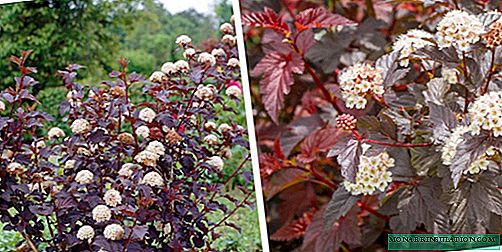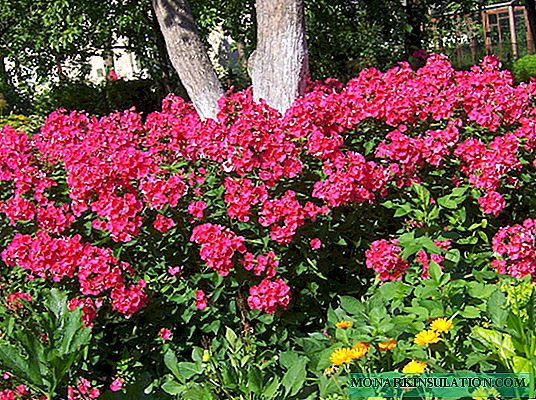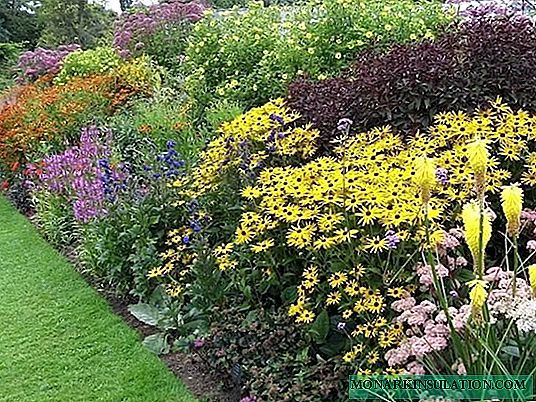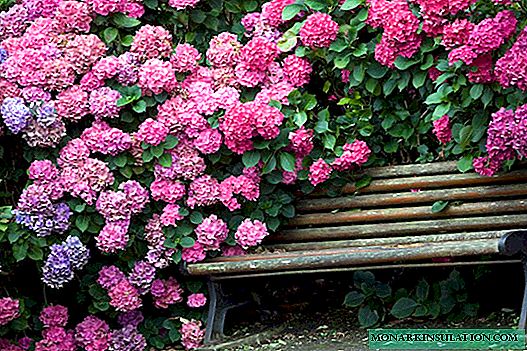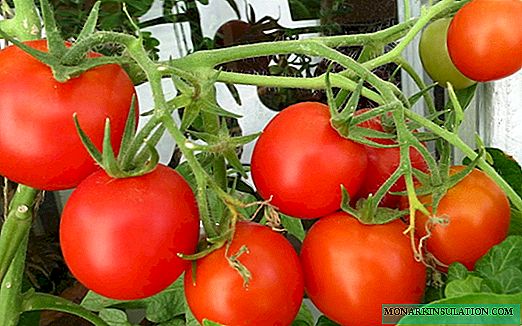
Any vegetables of early ripening are very popular. To date, a huge number of varieties and hybrids of tomatoes have been bred, but tomato White filling, known for more than half a century, is still actively planted by gardeners. This is due to its unpretentiousness and high resistance to weather vagaries.
Description of the variety White filling, its characteristics, region of cultivation
Tomato White filling was launched in the 1960s. in Kazakhstan at the experimental station named after V. I. Edelstein based on the varieties Victor Mayak and Pushkinsky. The aim of the breeders was to create a high-yielding early variety for any climatic conditions, and in 1966 a product of their work under the name "White filling 241" was included in the State Register of selection achievements of our country. All this time it is actively grown by both summer residents and organized agricultural enterprises.
This is a universal variety suitable for cultivation both in greenhouses and in unprotected soil of various climatic regions. Only at the official level by the State Register of the Russian Federation is it recommended for seven zones: Northern, North-Western, Central, Volga-Vyatka, Central Black Earth, Middle Volga and West Siberian regions. Thus, White bulk can be grown in both the south and the north of our country. This is due to its high resistance to cold, drought and other natural disasters.
Tomato bush White filling is low, but strong, due to the powerful rhizome, spreading in all directions. The maximum height of the bush is from 50 cm (in open ground) to 70 cm (in a greenhouse). The plant is a determinant type, does not require garter. The branching of the bush is average, the number of leaves is small. The leaves themselves are of usual green color, medium size, without fringing, their corrugation is low.

Bushes of White filling do not require garters, but sometimes so many fruits are born on it that gardeners help the bush not to fall
Variety White filling early ripe, the first fruits are ready for use 100 days after sowing seeds. About one third of the fruits ripen in the first week, further fruiting is extended. In general, from one bush, the yield is about 3 kg, in the greenhouse is slightly higher.
The first inflorescence in tomatoes of this variety forms after the 6th or 7th leaf, the next after another 1 or 2. In each inflorescence, from 3 to 6 fruits are born. The fruits firmly hold on to the bushes, do not fall on their own, even after full ripening. The weight of the fetus is on average about 100 g, it is smooth, sometimes slightly ribbed, rounded. Fully ripened fruits are painted in bright red color, but they acquire it through the stage of whitish color. Inside, ripe red tomatoes contain from 5 to 12 seed nests.
This is not to say that the fruits have a great taste. Taste qualities are characterized as good, tomatoes are intended for fresh consumption, the appointment according to the State Register of the Russian Federation is salad. They have a pleasant acidity, exude the usual tomato flavor. With a high yield, excess fruits can be preserved, they are suitable for the preparation of tomato paste. Well tolerate transportation, resistant to cracking.
Why, for more than 50 years, with the abundance of new varieties, White filling is in demand by gardeners. Apparently, a combination of factors plays a role here: high yield, coupled with early ripening, good marketability of fruits, resistance to cold and disease, ease of cultivation. The variety gives good yields in dry and cool years.
Video: characteristic of tomato White filling
Appearance
The fruits of the tomato White filling have a classic tomato shape, they are aligned, in ripe form they have the usual bright red color. However, in an unripe state, the color is faded, although the tomatoes are already quite edible.

Ripe tomato fruits White filling - smooth, red, like toys
At the same time, a large number of tomatoes with different colors can be on the bush, which creates the impression of a Christmas tree.

When the first fruits are almost ripe, the rest can be both green and white
Advantages and disadvantages, features, differences from other varieties
Like any other variety, White filling tomato has advantages and disadvantages, but the fact that it successfully competes with many new varieties and hybrids indicates that it has more pros than cons. The obvious advantages of the variety include:
- unpretentiousness to growing conditions;
- adaptability to various weather conditions;
- high, for an early variety, yield of beautiful medium-sized fruits;
- crop transportability;
- universality of use;
- good taste and strong aroma;
- friendly ripening of one part of the crop and extension of another;
- resistance to small frosts.
The disadvantages are:
- medium disease resistance;
- nondescript presentation of not fully ripened fruits;
- taste "for the amateur": not everyone loves the characteristic sourness of this variety.
The transportability of the fruit is associated with such a feature as a very dense skin. Being a plus from the point of view of the preservation of tomatoes, this fact, perhaps, introduces a negative connotation in the consumer (taste) characteristics of the fruit.
The name "White filling", fully suitable for apples of this variety, in the case of tomatoes is puzzling. After all, fully ripened ("poured") fruits are red in color, and they pass through the stage of white coloring during the ripening process.
The variety bears fruit well in all weather conditions, but in the case of sharp fluctuations in daily temperatures, the probability of cracking the fruit is still high. The first part of the harvest, as a rule, is excellent, but the success of the ripening of the remaining fruits already depends heavily on the weather.
Without questioning the unpretentiousness of the variety, I want to argue with statements about the excellent taste of tomatoes. There are many varieties that are almost not inferior to the White Bulk in unpretentiousness, but which give, in the opinion of the author of these lines, more tasty fruits. This variety, in particular, is Betta tomato. It ripens much earlier than the White filling, bears fruit in slightly smaller, but beautiful and tasty tomatoes. In leaving it is unpretentious as well as White filling. Although, of course, "taste and color ...". Probably, other gardeners will name a lot of other very worthy varieties.
Video: tomatoes White filling on the bushes
Features of growing and planting tomatoes
Despite the fact that Tomato White filling is very unpretentious, it has all the rules of agricultural technology applicable to the planting and cultivation of any other varieties of tomatoes, there are no significant features in this regard. Only in the south, this tomato variety is grown by direct sowing of seeds in the garden, and even then, if you do not want to get an extra early harvest. Basically, the story always begins with growing seedlings, and begin sowing seeds in boxes or pots in March.
The specific start date for seedlings depends on the region and on whether they plan to get a crop in a greenhouse or unprotected soil. After two months, the seedlings will need to be transplanted into the garden, and by then the soil will have to warm up to at least 14 aboutC, and air temperature should be expected at least at the same level. Therefore, in the middle lane, sowing should be done no earlier than mid-March, in the Lower Volga region this can be done a couple of weeks earlier, and, for example, in the Urals region - only in the last days of the month.
The process of growing seedlings consists of the following steps.
1. Seed preparation. The stage includes:
- calibration (agitation of seeds in a 3% solution of sodium chloride): pop-up seeds should not be planted;
- disinfection (bathing for 20-30 minutes in a dark solution of potassium permanganate, followed by washing with clean water);
- soaking and germination: the seeds are placed on a damp cloth and kept warm until small roots appear;
- hardening: keeping sticky seeds for 2-3 days in a refrigerator.

White filling seeds are the same as other varieties, and they are prepared for sowing in the same way
2. Preparation of the soil mixture. The best composition is a mixture of equal amounts of good garden soil, peat and humus. You can add a little ash to it (a handful on a bucket). A well-mixed mixture should be shed with a weak solution of potassium permanganate. However, the soil can also be bought in the store, it does not need to be specially prepared.

If a small amount of seedlings is grown, it is better to purchase ready-made soil
3. Planting seeds in a box. The soil layer in the box should be at least 5 cm, the seeds are sown in well-shed grooves to a depth of 1-1.5 cm, leaving a distance of 2-3 cm between them.

Sowing seeds one at a time is easy: they are quite large
4. Tracking the temperature. After 4-8 days, seedlings will appear in a glass-covered box at room temperature, the temperature is urgently reduced to 16-18 ° C, and at night - 2-3 degrees lower. Illumination - maximum. After a few days, the temperature is returned to its original level.

If you do not lower the temperature immediately after emergence, after a few days the seedlings can be thrown away
5. The pick. At the stage of two real leaves, seedlings are planted in separate pots or in a more spacious box, with a distance of at least 7 cm from each other.

The purpose of the pick is to provide each bush with a sufficient feeding area
In the process of growing seedlings, it is moderately watered and, if it stops growing, they are fed 1-2 times full mineral fertilizer according to the instructions. 2 weeks before disembarkation into the ground periodically take out to the balcony, accustoming to fresh air. Unlike many tomato varieties, one should not expect that large bushes will grow in two months: seedlings of the White filling rarely grow to a height of 20 cm, this is not necessary. It should be stocky, with a thick stem. Well, if at the time of planting in the soil on the seedlings buds or even the first flowers appeared.
Planting in a bed of tomato seedlings White filling is carried out with the onset of real heat. The site should be well lit and closed from cold winds. It is advisable to prepare the garden in the fall, adding all kinds of fertilizers to it. Tomatoes do not require ultra-high doses of organics, but they like high levels of phosphorus. Therefore, at 1 m2 make no more than a bucket of well-rotted manure, a handful of wood ash and necessarily 30-40 g of superphosphate.
White filling can be planted quite densely, up to 10 plants per 1 m2. Fortunately, it does not require garter, but in greenhouses this tomato is sometimes tied up, because there the bushes grow taller, and saving space requires them not to "scatter" around. Normal landing:
- They prepare a scoop of the hole according to the chosen scheme, a little local fertilizer (for example, a teaspoon of azofoska and half a glass of ash) can be added to each well. Fertilizers are mixed with soil and watered.
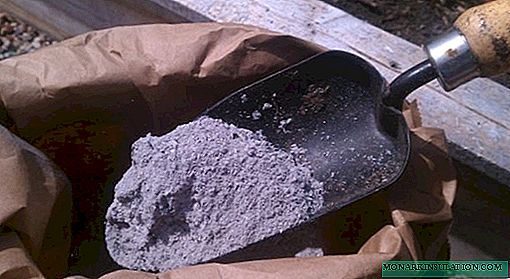
The application of ash under each bush contributes to the rapid survival of seedlings and intensive growth
- Carefully remove the bushes from a box or pots with a lump of earth and plant them in holes, deepening to cotyledon leaves. Since the White flood does not grow in the seedling stage with a tall bush, it almost never has to be planted obliquely.
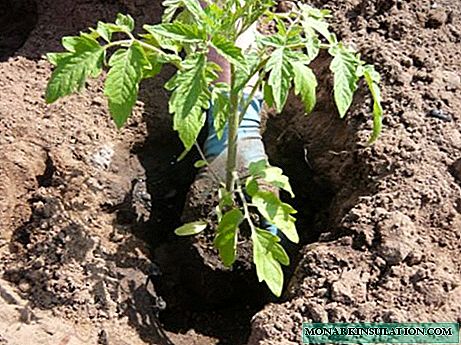
Good seedlings do not have to be deepened
- Planted with warm water (25-30 aboutC) and slightly mulch the soil around the bushes.
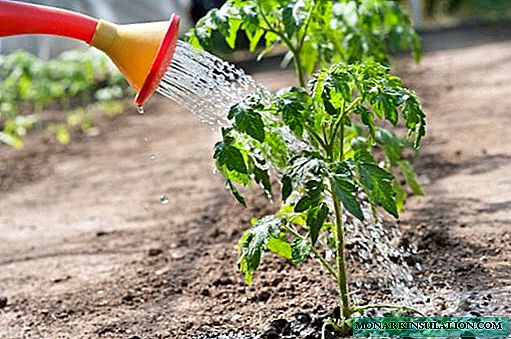
You can water the seedlings from a watering can, but it’s better not to soak the leaves once again
Caring for the White Bulk is uncomplicated. It consists of watering, loosening the soil with the removal of weeds and a couple of fertilizing. It is desirable to carry out watering in the evening with water warmed up in the sun. The maximum amount of moisture is required immediately after flowering, but as soon as the bulk of the fruit grows to normal and begins to stain, watering should be stopped to avoid cracking of tomatoes.
The first dressing can be carried out two weeks after transplanting seedlings, the second - another two weeks later. Any available fertilizer is suitable: both organic and mineral. The best option is a mixture: 20 g of superphosphate is added per liter of mullein and insisted in a bucket of water for a day. This bucket is enough for 10-15 bushes.
White filling does not require the mandatory formation of a bush, but sometimes with excessive growth (which happens from excess nitrogen nutrition) it is a little stepson. In this case, do not remove all stepsons, pinch only those that are clearly not in place. The sooner this procedure is performed, the better.
Due to the early ripening of fruits, White filling is very rarely exposed to fungal diseases, so it is almost never sprayed. In the case of prolonged cool and wet weather, it is advisable to carry out preventive treatment with folk remedies, for example, infusion of onion scales. Of the chemicals, it is advisable to use only the most "harmless", for example, Ridomil or Fitosporin.
Reviews
I tried White filling. I was delighted! Real tomato. No cherry can be compared. Next year I will grow real tomatoes.
Veronica
//www.tomat-pomidor.com/newforum/index.php?topic=158.180
Planted White filling two years ago. I had none. Since then, it’s a pity to take their place.
Galla
//www.tomat-pomidor.com/newforum/index.php?topic=158.180
Productivity is slightly lower than similar modern varieties and hybrids. Personally, I have been using this variety for only two years, but I have known about it since childhood. The variety is quite ancient, bred back in the USSR in the middle of the last century. In the Soviet summer residents it was one of the most popular varieties
Algam
//otzovik.com/reviews/semena_tomatov_poisk_beliy_naliv_241
Old proven grade. The variety is very early. I plant it for a long time. Now I have 8 varieties of tomatoes growing on the windowsill, including White filling. Completely unpretentious, no need to stepchild, weeding, watering and a little top dressing.
Tanya
//otzovik.com/review_4813860.html
Tomato White filling has been known for more than half a century, and is still in the cage of varieties of early ripening in many gardeners in Russia and several neighboring states. This is due to its unpretentiousness and good productivity. It is able to adapt to any weather conditions and does not require special care, therefore it can be recommended to summer residents who visit their sites only on weekends.






